This is the beginning of Pop's second diary which is in a much smaller book than the first diary. I think that Pop originally intended this book to be an address book because of its size and because the first remaining page contains addresses. I think the first two pages, which are ripped out, also contained addresses. Perhaps Pop ripped these pages out after he was married because they contained the addresses of old girlfriends.
Queen Mary Hospital
Roehampton
House
Roehampton
Surry
England
(Probably
the address of Pop's wife, who was then a nurse in England)
Roehampton Lane
Roehampton
Mrs Gaudet
Buckland’s
Hotel
Londond
(A
relative living in England)
Started the day I came back from leave, December 11, 1916
December 11
Bad day for me. Left Folkestone for France at 10:30 a.m. Lunch at Boulogne. Crossed with Robertson. Left Boulogne at 3:00 p.m. and went by way of Calais and arrived in Bethune (a large town in northern France)about midnight. Put up at the hotel for the night.
December 12
Drove to Bruay with Major Brown of 73rd . From there after lunch started to walk to Ruitz but met 73rd men again (?) and got a lift. It took me as far as Barlin and from there I walked to Maisnil-lès-Ruitz where our unit was billeted. It was snowing and raining.
Leighton was on a course and Longworth has left for England for an operation. Found lots of mail and parcels.
December 13
Still in billets and nothing doing at all.
December 14
Inspection in morning by General Byng, Corps Commander. Had quite a long march past Ruitz and he inspected us as we marched past. Saw Wallace for a few minutes.
Sir Julian Byng was commander of the Canadian Corps. (Service record, Library and Archives Canada.)
December 15
Parades in morning and afternoon. Gave out mother's Xmas parcels. Walked to Ranchicourt and saw General Burstall, then to Ruitz and then home here. Sent in my application for transfer to artillery. Hope it will go through. Will likely take some time.
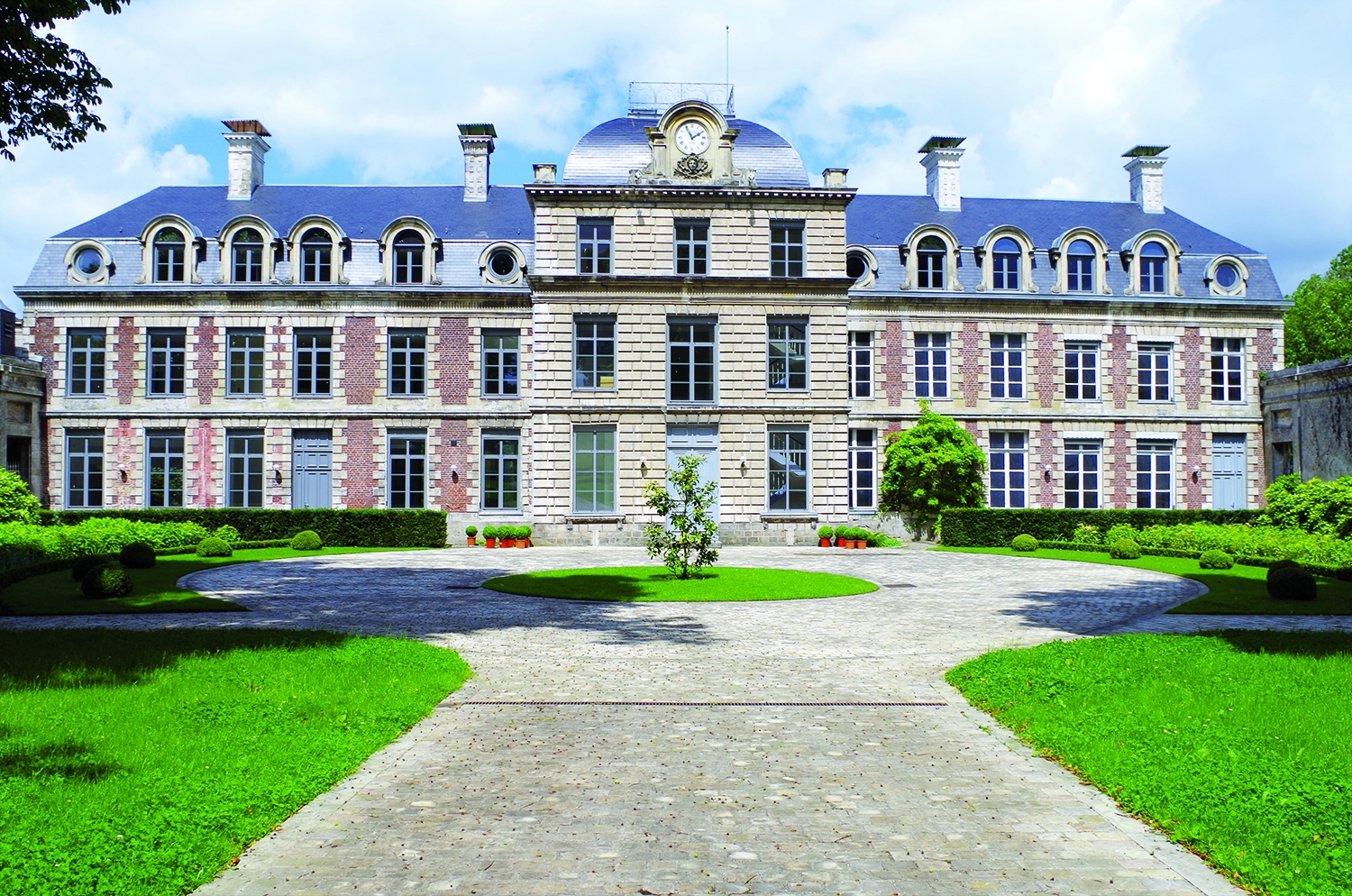
Le Château de Ranchicourt was the headquarters of the British First Army.
Sir Henry Edward Burstall was the commander of the 2nd Canadian Division. (Service record, Library and Archives Canada.)
December 16
Very quiet day in billets, just one parade in morning.
December 17
Sunday. Church parade which I did not attend as I went to Brigade Head Quarters about my transfer. Still in billets at Maisnil-lès-Ruitz, just at head of mine shaft no. 7.
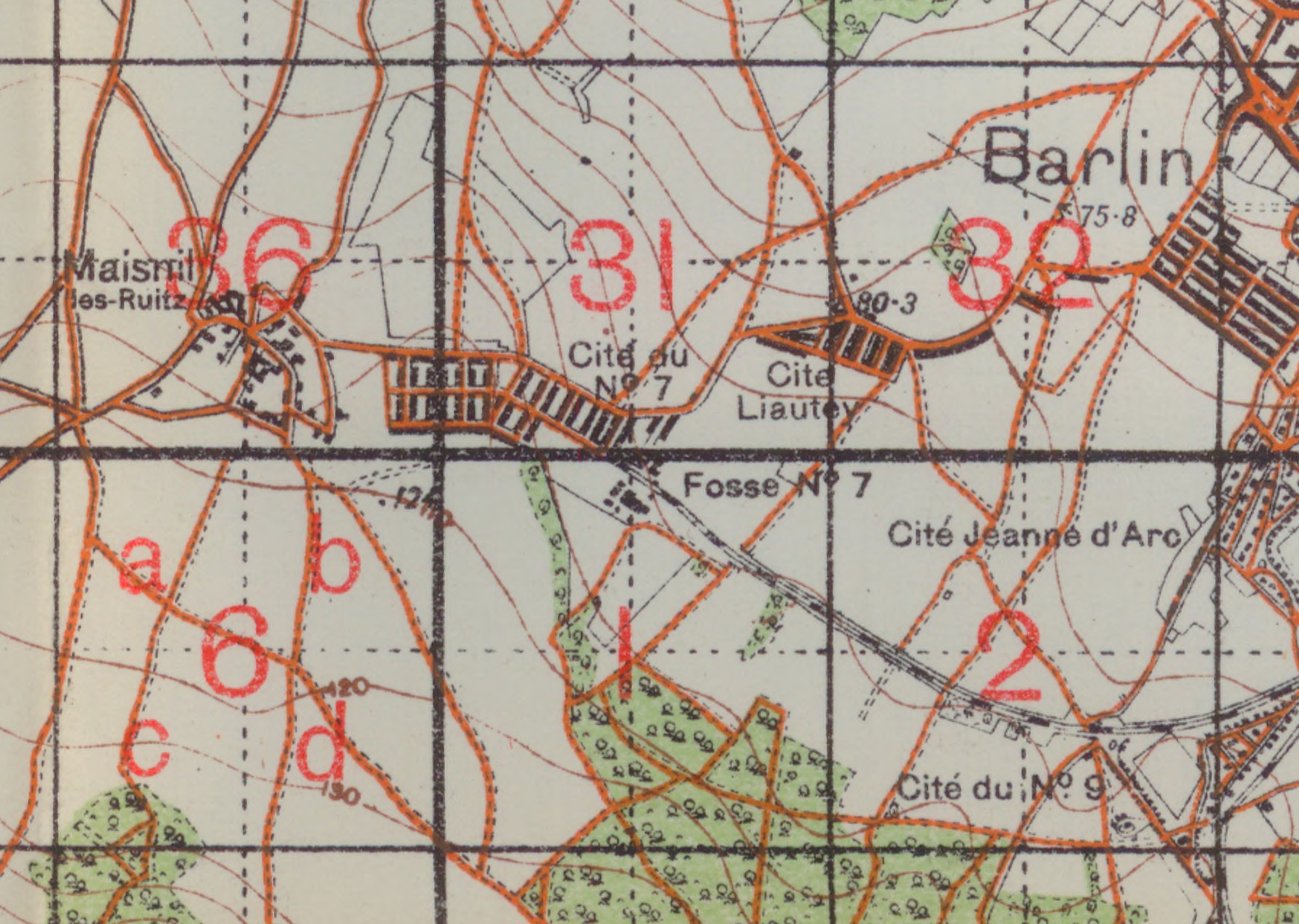
(France [Bethune], Sheet 36b, Edition 3, 1915.
WW1 Trench Map Collection, McMaster University.)
Mine shaft no. 7 was a coal mine with nearby houses built for workers. At the head of the mine shaft, Pop would have been staying in one of the row houses on what is now called Avenue de la Fosse 7.
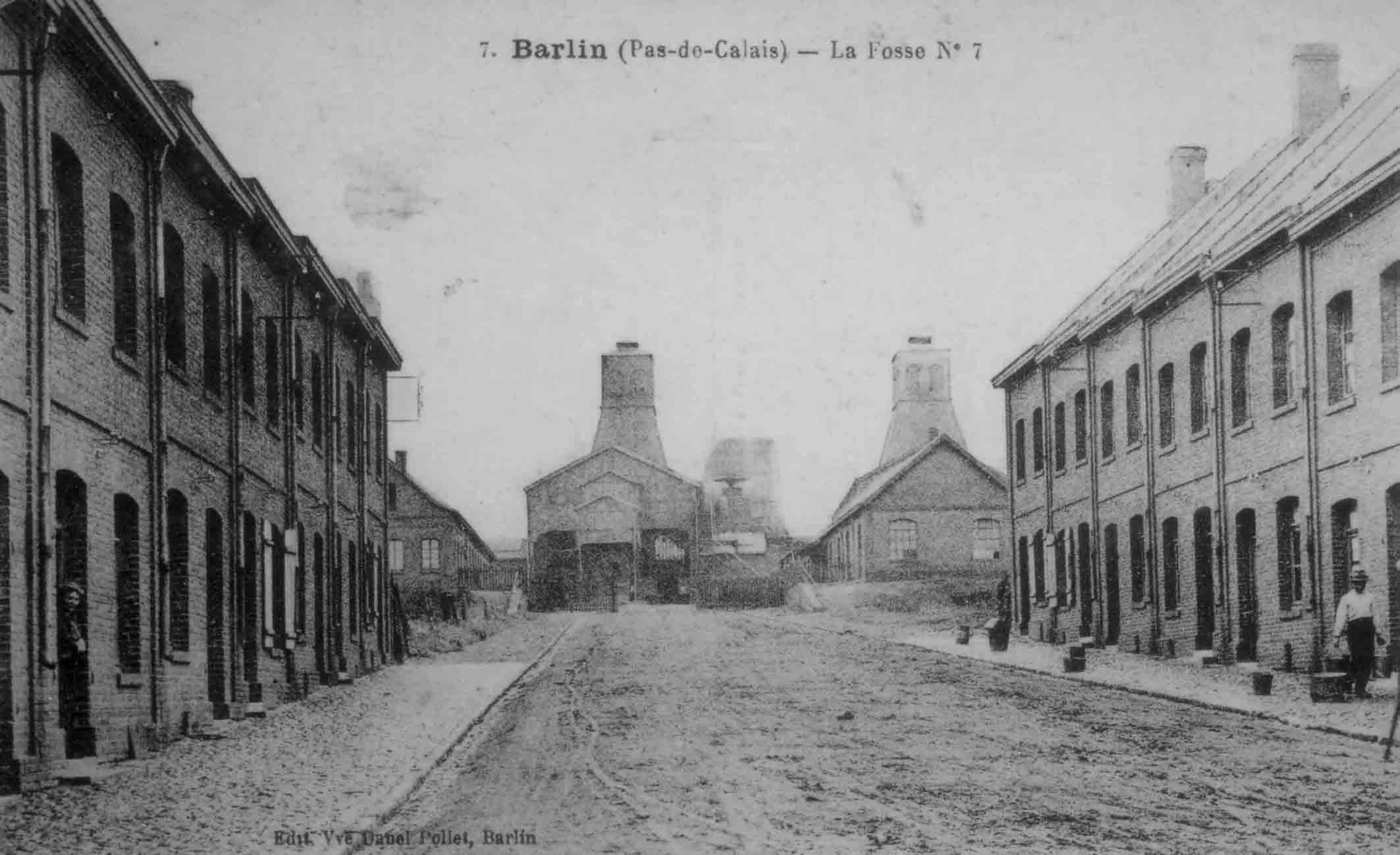
December 18
Ordinary parades, still in billets.
December 19
Ordinary parades still in billets. Snowstorm this afternoon.
December 20
Still in billets. Snow on ground and quite cold. Inspection by Brigadier tomorrow but I am going billeting (searching for a place to sleep).
December 21
Went billeting to Petit Servins, passed through Barlin and Hersin. Took over the 3rd Brigade Trench Mortar Battery billets and stayed the night with them.
December 22
3rd Brigade moved out early this a.m. I went and met our lot a mile or so out of the town. Raining and a nasty day, fairly cold.
December 23
Still in same billets. Captain Leighton went to look over the line with the other Officer Commanding. We go in tomorrow. Raining and cold most of the day.
December 24
Pedley and Wray went in today. Not my turn. Fine day but cold. Line very good from all accounts. Holding a church service here at 3:00 p.m. this afternoon. Spent Evening with Leighton and 78th Padres.
December 25
Raining and blowing. Leighton went up to the line. Wrote letters. In afternoon went to find 87th infantry but they were at Camblain L'Abbe, too far away. Not quite the usual kind of Christmas. Spent evening with some of the men.
December 26
Went to Brigade H.Q. at Villers au Bois and telephoned Leighton. Then went to Camblain L'Abbe and found 87th and had lunch with them. Jack Wallace was there, (two indecipherable words) and Major Gilday. Then walked home. Walked all the way getting a lift on a lorry now and again.
Archibald Gilday, DSO, was a surgeon from Montreal serving as a medical officer attached to the 87th Battalion. He would be wounded by a high-explosive shell in April 1918. He was “invalided” to Canada, where he continued to serve in the Medical Corps until the end of the war. (Service record, Library and Archives Canada.)
December 27
Did not do much all day. At 9:00 p.m. notified that 5 of our men who should have reported in the morning at Ranchicourt had not turned up. Went over with Sergeant Knox to find out. Its now reported that it was a mistake at their end. Did 5 hours hard walking, a good 10 miles and got back at 1:00 a.m. Night fine and cold. Did not know way but had a map.
This was a possible desertion, an offense punishable by death in the First World War.
James Errol Knox was a 26-year-old farmer from Gladstone, Manitoba. He would be decorated for bravery on January 20th, 1917. He was killed by an artillery shell on March 1st, 1917. (Service record, Library and Archives Canada.)
December 28
Men paraded to Gas school. I went to Brigade H.Q. on a bicycle to arrange a few things. Nothing much doing.
December 29
Cold and raining. Did not do much today except got ready to go to trenches tomorrow. Had a bath in the afternoon. Men had a smoking concert in the evening which I attended.
December 30
Came into trenches with relief. Trenches full of water and very bad but up in the line alright. Our quarters good and gun position fine. Wray went out. Everything pretty quiet, we fired about 100 rounds.
December 31
Overcast and blowing hard. Captain Leighton went out. In afternoon, went up to front line to observe. Quite a trench mortar fight was up, over about 820 rounds during the day. Had a close shave from a piece of high explosive shell near no. 6 gun. In morning carried up quite a little ammunition with infantry carrying parties. Night pretty quiet.
1917
January 1
Overcast and blowing hard. Infantry carrying party for ammunition all morning. Fired quite a lot. Enemy shelled Zouave Valley close to our H.Q. about 11:30 a.m. and intermittently at other times. Went up to 78th H.Q. and saw Officer Commanding about co-operation. His trench mortars fairly active all day. Particularly around no. 5 gun.
The officer commanding the 78th Battalion was James Kirkcaldy, a 50-year-old city assessor from Brandon, Manitoba. Before the war, he served in the militia, and had previously been Brandon's Chief Constable for 13 years. He had suffered a gunshot wound in the chest in 1915 while fighting with the 8th Battalion at the Second Battle of Ypres. He was sent back to Canada but returned to France with the 78th. He would be wounded again in 1917 during the Battle of Passchendaele, but he survived the war and returned to Brandon, where he later served as an alderman. (Service record, Library and Archives Canada.)
January 2
Quite a day for trench mortars. We fired over 300 rounds and they came back pretty strongly at times with sausages mostly. Nearly got one myself during the afternoon. Was up in the front line myself most of the afternoon observing. Fired 25 rounds at a suspected sniper post. Seemed to land about the right spot. Heavies and Mediums also firing quite a bit. McKenzie came up this p.m.
Sausages
"Sausages" were shells fired from the German 240 mm Albrecht mortar.

As of Septemer 2018, we know of no source that makes this connection between the weapon and its nickname. But Great War Forum user archangel9 provided a decisive piece of evidence. An October 1916 entry in the unit war diary of the 10th Battalion, Essex Regiment contains a sketch of an unexploded shell, which the artist labels "sausage". It seems clear that this unusual shell, cylindrical with a handle at one end, is the same as that in the above photo of the Albrecht.
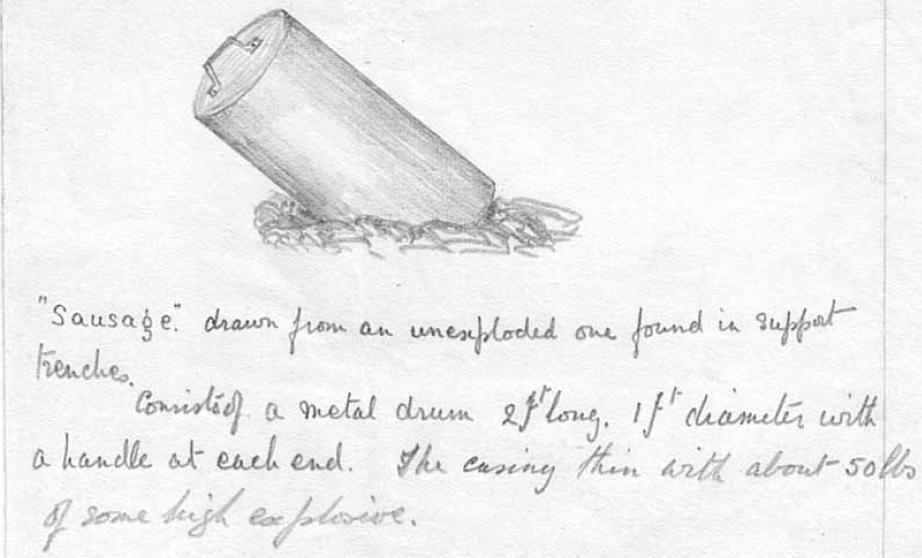
Robert Graves, a British poet and World War I infantry officer, describes sausages in his autobiography, “Good-Bye to All That”:
'Sausages' are easy to see and dodge, but they make a terrible noise when they drop... we pick out at once the faint plop! of the mortar that sends off a sausage... The company sergeant-major stands behind Number Eleven brick-stack and shoots at sausages with a rifle as they come over; trying to explode them in the air. He says that it's better than pigeon-shooting. He hasn't hit one yet.
January 3
Heavy shelling and trench mortar work about 7:00 a.m. Our guns quite busy. Strafe lasted quite a time and was fairly heavy. Had to go to 78th H.Q. at 10:30 a.m. Enemy shelling very heavy on the way. Did not like it at all. Had some very close shaves. No. 4 gun knocked out of action about 8:30 a.m. Gun buried and men buried but not hurt. Enemy shelling with artillery and trench mortars very heavy till about 1:00 p.m. We got no support from our artillery. We fired nearly 600 rounds from our guns.
No. 4 gun would have been buried by the near miss of a high explosive shell.
January 4
Captain Leighton came up yesterday afternoon. Went with him in the morning to meet General MacBrien and he went around our guns and seemed well pleased with them and our work yesterday. Very quiet day and nothing doing at all.
Mortars had to be well camouflaged, dug in, and sited away from the main trench lines which were plotted on maps by the Germans using aerial photographs and which were the main targets for artillery.
James Howden MacBrien, a 38-year-old career army officer, was commander of the 12th Canadian Infantry Brigade. (Service record, Library and Archives Canada.)
January 5
Fine morning. Germans started shelling and trench mortars about 9:30 a.m. and gave us hell. Nearly got Sergeant Knox and myself with a minnie in Granby trench. Nearly got one dugout. About noon dugout at no. 7 gun blown in and four men buried. Went up at once with Sergeant Knox, shelling like the devil. Got out three of them, two hurt but not badly. The other, Corporal Woodworth, was killed. Had to get engineers and they dug till 2:00 a.m. next morning. Just got to him and could see his face hard and he was dead. The whole thing caved in again and nothing more could be done.
Lawrence Albin Woodworth's remains were never recovered. His name is inscribed on the Vimy Memorial, which commemorates Canadians killed in France with no known grave. (A photo of this inscription is available on Soldiers of the 38th.)
Dugouts were often deep to withstand artillery shells but their entrances could be collapsed by a direct hit, trapping the men inside. For Pop and Sergeant Knox to go out under shell fire to dig their men out was a brave thing to do. Pop also remained at the dugout until all his men were accounted for, though this took until 2:00 a.m. He must have been exhausted from lack of sleep, the physical effort of digging, and the mental stress from the shelling.
“Minnie” was slang for a class of German mortars called minenwerfer (“mine thrower”).
January 6
Captain Leighton came up with relief and I came out. Fine day and everything quiet. Our artillery due to put on a show tomorrow.
January 7
Very quiet day in billets. Lieutenant Halton reported to us. Had a great sleep last night. Used Katie's eiderdown for the first time. We were supposed to put on a strafe today. Don't know whether it came off or not.
Walter Tyroll Halton was a 37-year-old civil servant, born in England. He would be wounded twice before returning to Canada. (Service record, Library and Archives Canada.)
January 8
Very quiet day in billets. Raining and rotten weather. Had a good bath, the most important thing of the day.
January 9
Left for trenches about 9:00 a.m. arrived about 11:30 a.m. We started a strafe about 2:00 p.m., artillery and trench mortars lasting about 2 hours. Fritz had put over a heavy strafe in the morning just before I got in. Day raining and rather rotten. He had given us two strafes since I went out, making two direct hits on Head Quarters. One was a dud and it stood the other alright but was a bit dinged in.
Head quarters were deep underground, with corrugated steel roofs supported by railway ties or railway rails.
January 10
Very quiet today, only a few sausages now and again. Our artillery fairly active particularly on our left. M. Halton came up today and relieved Mackenzie. Gas alarm about 5:30 p.m. but evidently a false one. Night very quiet after that except on our left where the devil was on.
January 11
Battalion relief, very quiet in the morning. About 2:30 p.m. enemy trench mortars got very active and we retaliated, also heavies and mediums. Our artillery fairly active.
Mortars did not fire when troops were being relieved for fear of retaliation when infantry was exposed walking up and down the communication trenches.
January 12
Rain and sleet. Trying to spot a sniper's post and working party. Enemy trench mortars fairly active during the afternoon. We retaliated fairly heavily. Our artillery fairly active. Enemy artillery quiet. Relief came up today for the men.
January 13
Last night enemy trench mortars active for a couple of hours. Our guns replied and also the artillery. Pretty hot for a time. Rest of day fairly quiet. No. 6 gun blown in and dugout partially so. No casualties. Wray came in and Halton went out for a course. Temporary pit at no.7 gun also blown in partially and these two guns were taken ont of the line till we can fix things up.
January 15
Morning cold and misty. We were going to put on a bombardment but it was put off owing to poor observation. Pedley came in and relieved me and I came out. Very quiet nothing doing at all.
Accurate shooting required observation to correct aim for the effects of wind.
January 16
Very quiet day in billets. Cold and freezing hard. Heavy barrage by our artillery about 4:30 p.m. Captain Leighton left on leave this evening.
January 17
Another heavy barrage this morning. Turned out to be a raid by 2nd Division. Wray came out and McKenzie went in. Very quiet day in billets.
January 18
Very quiet day, still in billets. Lots of snow on the ground last two days.
January 19
Had to move our rear H.Q. to hut no.1, a darn cold spot and weather cold with snow. Went to Brigade H.Q. in morning.
January 20
Parade for presentation of honours. General Officer Commanding presented Military Medal ribbon to Sergeant Knox, Corporal Lambert, and Privates Calverly and Halcrow. Did nothing else all day but sit around the fire. Go to line tomorrow to relieve Pedley.
The Military Medal was an award for bravery.
Sergeant Knox was in command of no. 4 gun which was buried by a near miss on January 3rd, 1917. Knox was also involved in digging out the crew of no. 7 gun while under artillery bombardment on January 5th, 1917. The awards may have been for one of these two actions.
George Henry Lambert was a 21-year-old farmer, born in Leeds, England. He would be promoted to sergeant and survive the war. (Service record, Library and Archives Canada.)
Orval Earl Calverley was a 20-year-old mechanic from Hayfield, Manitoba. He would return to Canada after being wounded. (Service record, Library and Archives Canada.)
James Garrick Halcrow was a 26-year-old engineer, born in Leith, Scotland. In May 1919, he would be awarded a bar to his Military Medal, in recognition of a second act of bravery). He was wounded by a gas shell but survived the war. (Service record, Library and Archives Canada.)
January 21
Came in to relieve Pedley. Weather cold and ice on trench mats, making walking bad. Everything quiet. Been so for some days now. Left Petit Servins at 9:30 a.m. Arrived at trenches 12:30 p.m.
January 22
Fired about 10 rounds last night at snipers post. Little strafe in the morning about 9:30 a.m. We fired about 50 rounds. Corporal Ewen killed by shell just outside of H.Q. dugout, the only shell that came near there at all. Fired about 75 more rounds in the afternoon in retaliation.
The fallen is Carlbert Ewen.
January 23
Very quiet Battalion relief on. We did not fire at all. Wray relieved McKenzie. Saw aeroplane fight during the afternoon. One came down in flames, not sure whether ours or theirs. Enemy fired a few rounds of shrapnel during the night.
January 24
Relief did not come up as men in quarantine. Day quiet and very little shooting by our guns. Enemy did a little shelling during the night.
Quarantine was the main method of controlling infectious diseases in WW1, before there were many vaccinations or antibiotics.
January 25
Day quiet. Went to conference at advanced Brigade H.Q. Nothing much doing. Both sides did a bit of shelling and Trench Mortar work.
January 26
Fine and clear. Got after sniper at Kennedy Crater. Moved two guns up and had a telephone in front line connected with guns for registration. Registered each gun separately and then gave 100 rapid and gun crews took guns back. Everything seemed to go up. Things certainly flying for a bit. He came back with Minnies but did no damage. No other firing. Enemy did a little shelling.
Kennedy crater was large hole created by a mining operation earlier in the war. It was a prominent feature of the landscape near Vimy Ridge and is mentioned in books and shown on maps of the area. Kennedy crater was about 100 yards in diameter and occupied the whole breadth of no man's land in that part of the front. The lips of the crater formed the parapet of the front line trench on both sides. Pop observed from the front line on his side of the crater and communicated with his gunners farther back by telephone giving them corrections to bring their guns on target, which was a sniper in the enemy front line trench.
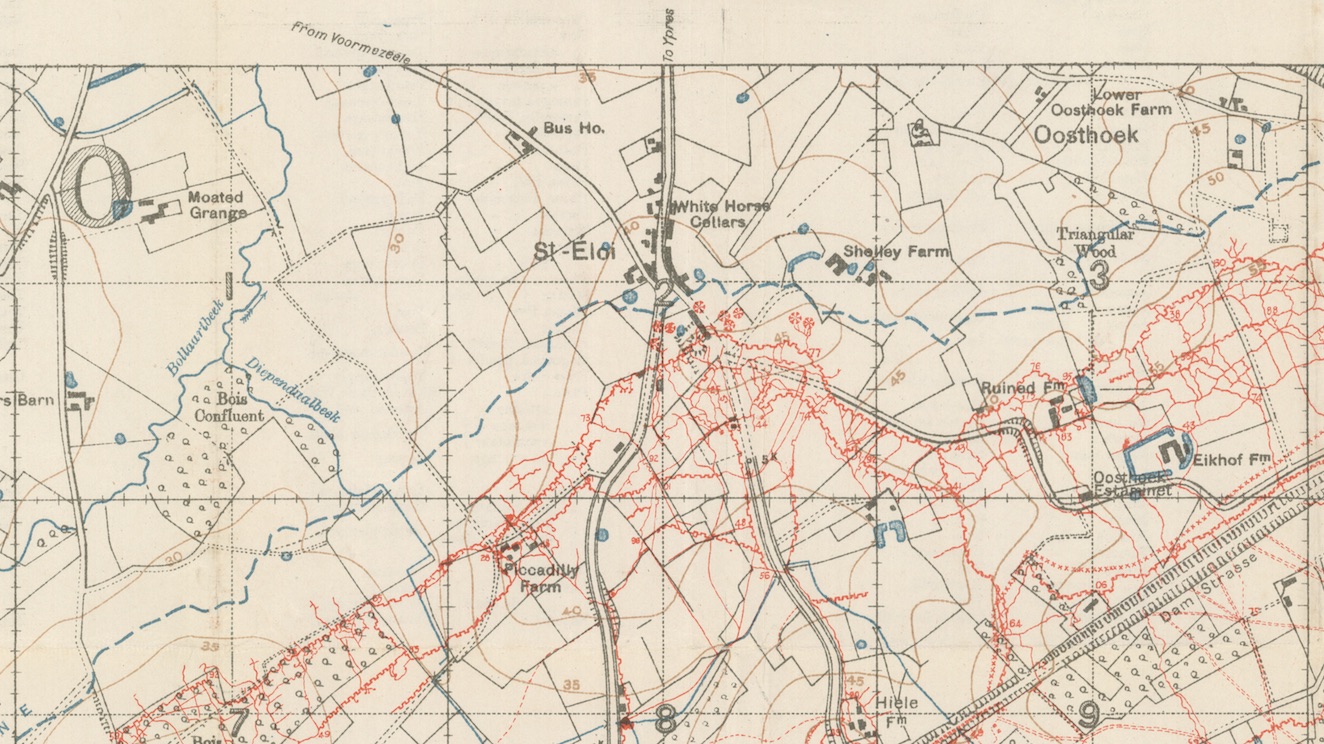
(Vimy, Sheet 36c SW3, Edition 8a, 10 February 1917.
WW1 Trench Map Collection, McMaster University.)
Mortars make a distinct noise and smoke. In this action, Pop was close enough and the view was good enough across Kennedy crater that enemy observers could direct artillery at his guns soon after they fired. Therefore Pop had to register, fire on target and then move the guns and crews back, all as quickly as possible.
January 27
Kaiser's birthday. I was relieved by Pedley about noon, up to that time nothing doing. Our people expected Huns to bombard us by way of celebration and we had orders to retaliate at once. Only it did not come off while I was there. Came out by Hospital corner and Carency and got a ride on a lorry most of the way. Had a long chat with H. Staveley.
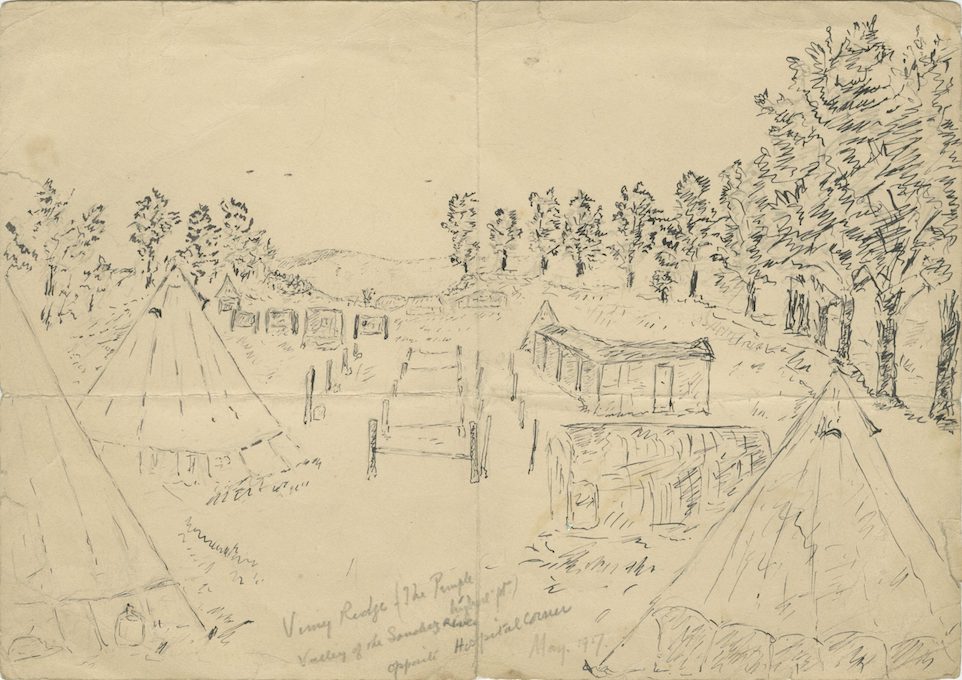
(Drawing, Vimy Ridge from Souchez Valley, Canadian War Museum.)
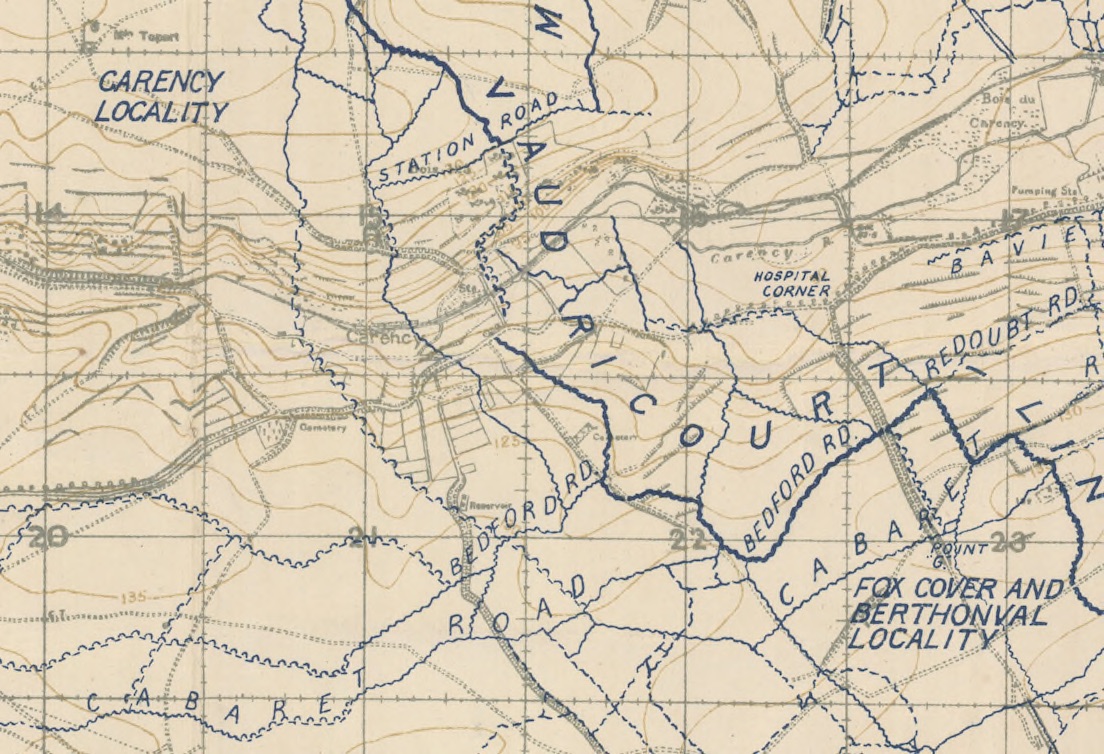
(France, Sheet 44b(36b) SE, Edition 8a, 22 May 1918.
WW1 Trench Map Collection, McMaster University.)
Harry Lorne Staveley was a 38-year-old clerk, born in Quebec City. He would later be wounded by a gas shell and return to Canada. (Service record, Library and Archives Canada.)
January 27–February 2
Spent in billets, nothing exciting. February 1st went to Barlin with Wray for a bath.
February 3
Relieved Pedley everything fairly quiet. Picked out position for our guns for raid to come off Sunday. Pedley and both crews remain in.
February 3
(second entry for this date)
About 1:00 a.m. this morning, fired 20 rounds at working party reported and 20 more later on to cover raid of 72nd at 4:30 a.m. which was not a great success. Rest of day fairly quiet except for readied (?) location on Kennedy Crater for raid in evening. About 9:00 p.m. we covered right of 10th Brigade raiding party with four guns. Fired about 350 rounds. Raid a big one and very successful. Retaliation very heavy but slow in coming.
February 4
Morning took 4 inch stoke up and showed them the ground. Put in our guns and registered them. Had 14 guns = 7 of our own, 4 from 10th and 3 from 11th. Our men ran them all. Raid at 2:00 p.m., fired about 1400 rounds. Halton shaken up by a shell and one man bruised later by an explosion of one of our own bombs. We had five men wounded just outside of Head Quarters.
February 5
Very quiet today and fine and clear. We did not do any shooting. Stood by at night to shoot on relief of machine gun post but it did not come off.
February 6
Very fine and clear. Gas alert on. Examined all helmets. Went over line with Brigadier and Colonel Kirkcaldy of 78th. We did no shooting at all. Enemy very quiet.
February 7
Fine and clear. Gas alert on. Spent morning arranging for shoot on sniper's post. At 3:00 p.m. shot on sniper's post near Ersatz. Fired about 140 rounds. Some hits but shooting erratic on account of wind. Otherwise day very quiet.
Ersatz crater, and Ersatz trench leading up to it, are marked on the same map that shows Kennedy crater (see grid square S14b).
February 8
Day fine and very quiet. A fire started in the Head Quarters dugout about 9:00 a.m. and set off a bomb (mortar bomb, artillery shell or hand grenade) that had evidently been built into the wall. It killed my batman Wilson and cut Lieutenant Wray badly about the face, not sure if his eye is injured. Pretty close shave all around.
The fallen is Charles Wilson.
February 9
Very fine day and quiet. Working on our dugout. Pedley came up to take Wray's place. Very quiet on both sides. Night before last, 38th shot a Fritz just outside our wire, part of a patrol. They put him in last night (buried him). Heard that Wray's eye is alright.
In the First World War, both sides honoured enemy dead with military funerals and burials whenever possible.
February 10
Fine and quiet. In afternoon, we fired about 130 rounds at snipers post opposite International, good effect. Intended to fire on Hun relief on left sub section (?). But owing to Patrols and working parties of ours, we did not do so. Our artillery very active between 7:00 and 8:00 p.m.
February 11
Very quiet all day. Overcast. A very heavy enemy barrage on left sub sections about 8:00 p.m. Our guns replied and our artillery retaliated heavily. Very few casualties in the 78th who got the worst of it.
February 12
Overcast and cloudy with a little snow. Our artillery fairly active. We fired at snipers post opposite International. Silenced him for the time being.
February 13
Raid by 10th Brigade last night or rather 4:00 a.m. today. Very successful, 1 officer and 50 other ranks taken prisoner. Heavy barrage, our guns took part and fired about 600 rounds. Today very quiet. Captain Leighton came up for a few minutes. Day fine and warmer than we have been having.
February 14
Very quiet day. A few sausages near no. 5 gun for which we retaliated. Artillery normal on both sides. Captain Leighton came up and we are fairly tense preparing for a show.
February 15
Quiet day, working like the devil preparing for a show. Have to put in 21 guns right up and prepare ammunition and register the guns as our barrage is to be close to the raiding party and a very delicate one.
“Delicate” means that the raiders would cross no man's land, cut through the barbed wire and approach the enemy trenches very closely before the covering barrage was lifted. The moment when the barrage was lifted was determined by time rather than by any sort of signal because signalling was too unreliable and portable radios did not exist.
February 16
3:00 a.m. this day the 72nd put on their raid. We fired 21 guns with our own personnel, firing over 2000 rounds. Infantry reported barrage excellent and they were not fired on at all going in. Our party took 11 prisoners and bombed dugouts and found quite a number of dead in the trenches. Raiding party had three casualties, all wounded, two of them slightly. We had no casualties except one man slightly scratched but still on duty. I came out to billets after lunch and was relieved by McKenzie. Morning was quiet.
February 17–21
In rest billets. On 19th a raid by 78th. We operated about 20 guns, firing about 2000 rounds.
February 22
Came into line to relieve Pedley. Spent rest of the day registering guns and preparing for raid. 38th and 78th raided at 5:30, we ran 16 guns firing about 1700 rounds. 11th brigade ran 4 guns on left and 10th two on right. Enemy retaliation fairly heavy and raid successful, all parties but one getting in (i.e. into enemy trench). No prisoners brought back. Quite a few killed and dugouts bombed.
February 23
Quiet except Huns put on a strafe about 3:00 p.m. and another about 6:00 p.m. Our artillery retaliated heavily. We fired about 70 rounds from 3 - 4 guns. Had to send for rations to Advance Brigade Head Quarters. No mail. Very short of candles (to light dugouts).
February 24
Day fairly quiet except for Hun strafe about 3:00 p.m. Our guns did not fire. Our artillery active. Received operations order in evening concerning raid.
February 25
Day quiet. Prepared for raid and set and registered our guns. German strafes in afternoon and very heavy between 6:30 and 7:00 p.m., making direct hit on our dugout with High Explosive. (indecipherable) put up his S.O.S. (a rocket flare).
February 26
Day quiet except for occasional artillery on both sides. Our planes up and flying very low. Work repairing one dugout which was pretty badly bust up. Pedley came up today. Wind not right for raid.
February 27
Quiet except for the odd shell. One of our guns and ammunition blown up on left last night, no crew with it luckily. Wind no good for raid.
This raid was to use poison gas as well as mortars and artillery for cover and so required a light wind blowing toward the enemy.
February 28
Day quiet except for occasional shelling. Decided at midnight to pull off raid early tomorrow.
March 1
Raid this morning. Two waves of gas at 3:00 and 5:00 a.m. Our guns took part in barrage to cover infantry. Fired for 10 minutes. No.4 gun hit direct and Sergeant Knox, Welch and Naffin killed. Retaliation heavy and gas not a success and raiders suffered pretty heavily. Fritz seemed to be ready. Rest of day fairly quiet. During night enemy made a direct hit on our Head Quarters with high explosive. No one hurt.
The fallen are James Errol Knox, Frederick Welch, and Rudolph Naffin.
March 2
Pretty quiet all day, odd shells now and then but not bad. Expected to go out but had to stay in and help out the 10th and 11th Brigades. The 87th Canadian battalion (part of the 11th Brigade) is taking over this area. Saw Percy Law and some of the others.
Percy Robert Law was a 28-year-old from Montreal, where he worked in insurance. He had already been awarded the Military Cross with a citation for conspicuous gallantry. He would be wounded by machine gun fire at Vimy Ridge. (Service record, Library and Archives Canada.)
March 3
Getting ready to go out when told had to stay. Shrapnel at odd times. Parties from both sides up in no man's land collecting dead.
In the First World War, there were frequent local truces to collect dead and wounded in no man's land.
March 4
Quiet day practically nothing doing. During the evening heard artillery on our right. No shooting by our guns.
March 5
Snow again. Huns strafed fairly heavily about 6:00 a.m. in valley and near our dugout. No. 1 and 2 guns fired about 25 rounds apiece on enemy front line trenches.
March 6
Everything very quiet. Was relieved by Maclean and came out to billets.
Victor Wolever Maclean, a 29-year-accountant born in Montreal, had just joined the 12th Trench Mortars. He would be awarded the Military Cross with citation, before being severely wounded at Passchendaele, and returned to Canada. (Service record, Library and Archives Canada.)
March 7
Moved our billets to Hersin, very comfortable there.
March 8
Went to Barlin for a bath.
March 9–10
Still in Hersin.
March 11
Moved to Chateau de la Haie.
March 13
Went to 10th Brigade, attached to staff.
March 14
Went up to line with Major O'Donahoe. Rode to Hospital Corner and back. First experience of this sort of thing, pretty sore but hung on.
Pop disliked horseback riding and once told me he stayed off of horses as much as possible.
James Vincent Patrick O'Donahoe was a 35-year-old transportation manager from Montreal. He would be awarded the Distinguished Service Order, mentioned in despatches, and appointed commanding officer of the 87th Battalion, but eventually died of wounds. (Service record, Library and Archives Canada.)
March 15
Raid pulled off not a success.
March 16
Went with Howard to arrange to train some of his men in stokes.
March 18
Gave some instruction to 10th stokes and worked in office.
March 20
Moved into tent, cold and snowing.
March 22
Rode to Bouvigny on bicycle to see Battalion P.M.'s (?). Our artillery very active last night. Advance south of us continuing well.
March 23–27
Still with Brigade.
March 28–31
Still at Brigade. Night of 31st 1st Brigade pulled off a raid, quite successful and prisoners taken.
April 6
Went up to Observation Post on Lorette Ridge (marked as a scenic point on Michelin map 236 and now the site of a Cimitere National). Great view of enemy lines and back country. Quite heavy artillery on both sides.
April 9
Easter Monday. Attack on Vimy Ridge by whole Canadian Corps. Very successful.
April 10
10th Brigade took Hill 145 and beyond.
April 11
Spent day up line refitting 44th and 37th.
April 12
Last night 10th Brigade took the Rinph (?).
April 13
Took Vimy, Lievin, etc.
April 21
Went up to new line with Robertson looking for a new Brigade Head Quarters for next shove. Fairly heavy shelling.
April 23
Imperials attacked on our front. Not a great success.
April 24
Brigade moved in again.
April 28
4:00 a.m. attack by 1–2 divisions.
May 5
Attack by 46th and 47th successful. Went up with Egourde (?) looking after ammunition.
May 11
Relieved by 11th Brigade.
May 19
Left for England. Drove with Wallace in motor car to Bethune.
May 20
Arrived in London. Met Katie at Carlton.